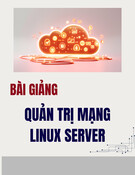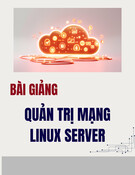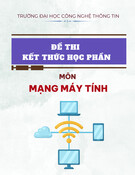
The DNS server replies not with the private (nonroutable) address, but with the
mapped address in the NAT reply (in this case, 169.254.99.1), as established in the
previous step. Once this DNS/NAT procedure is complete, the transaction in bidirec-
tional NAT continues (as shown in Figure 27.3).
Naturally, requests from local LAN devices are still handled as in unidirectional NAT.
Port-Based NAT
In both unidirectional and bidirectional NAT, the address translation is always one to
one. Even when dynamic mapping is used, the entire inside address is always swapped
out for an outside address. But we set up our examples by saying that 250 LAN hosts
are going to share only 20 public IP addresses.
Unidirectional and bidirectional NAT handles 20 or fewer simultaneous Internet
users on the LAN. But what happens when more than 20 hosts are trying to access the
Internet all at the same time?
That’s where port-based NAT, also called overloaded NAT, comes in. Some devices
even advertise this as network/port address translation (NAPT) or port address transla-
tion (PAT), but we’ll just call it port-based NAT.
We are now essentially translating sockets from inside to outside. With port-based
NAT, we can easily have all 250 devices with outstanding requests on the Internet all at
the same time and never come close to running out of port numbers (which run from
0 to 65,535).
Let’s say that one host on the LAN is already using private address 10.100.100.27
and source port 17000 (perhaps the browser always uses that source port number) to
contact a Web site. No problem. Port-based NAT just translates both IP address and port,
as shown in Figure 27.4.
“Inside” LAN “Outside” Internet
Host Host
NAT
Device
Request
Dest: 250.99.111.4: 80
Source: 10.100.100.27:17000
Reply
Dest: 10.100.100.27: 17000
Source: 250.99.111.4: 80
Reply
Dest: 169.254.99.1: 18395
Source: 250.99.111.4: 80
10.100.100.27
Request
Dest: 250.99.111.4: 80
Source: 169.254.99.1: 18395
4. NAT on dest addr and port 3. Server sends reply
1. Client sends request 2. NAT on source addr and port
250.99.111.4
FIGURE 27.4
Port-based NAT, showing translation on both address and port.
CHAPTER 27 Network Address Translation 689

Port-based NAT is usually how DSL routers share a single ISP address among four
or more home PCs. Most NAT implementations today are capable of port-based opera-
tion. However, this does not mean it’s always done when available. Not all applications
or their packets use UDP or TCP ports, and port-based NAT cannot be done on these
packets.
Overlapping NAT
This last type of NAT, also called “Twice NAT,” is quite different from the three other
types. All three previous types used private nonroutable IP addresses as a “substitute”
for global routable IP addresses. NAT routers immediately assume that any packets
drawn from the local LAN’s private IP address space are a reference to a host within
the local LAN. Anything else belongs to the outside world.
But what if the inside addresses overlap entirely or in part with addresses used in
the outside world? In other words, what if there is another 10.100.100.0/24 address
range on the “outside” that the local device using that private address space must com-
municate with? There are three major cases where inside addresses on a LAN might be
duplicated in the outside world.
Private network to private network—NAT routers tend to use the same pri-
vate address ranges, such as 10.0.0.0/8 (Cisco DSL routers and more) or
192.168.0.0/16 (Linksys products and others). So, this situation arises in DSL
router configurations (such as neighbor to neighbor) all the time. And organi-
zations often merge and find two sites now using the same private IP address
ranges.
Reassigned addresses—Many customers get their IP address space from their ISP.
But what if they change ISPs? The ISP is certainly free to offer that space to
someone else. Instead of flash-cutting every IP address on the network, NAT
can be used for the new ISP until cut-over is complete. And even if customers
pay for their own address spaces, these can be reassigned if the payment is not
up to date.
Private IP networks going “public”—This does not occur as often, but it was once
common to have huge IP networks within an organization with no Internet access
at all. (Networks are for work, the Internet is for play, or so the philosophy went.)
So who cared what IP addresses were used on the private network? But if a space
such as 9.0.0.0/8 is used (which belonged to IBM) something must be done when
Internet connections become essential.
Thus, when a host on the local LAN sends a packet from 10.100.100.27 going to
10.100.100.10, how does it know whether the address is truly local or not? Local
frames have local MAC addresses, but “outside” packets are sent in MAC frames that are
sent to the router.
Someone has to know where the other address is or there will be no solution. As
before, DNS will coordinate with NAT to supply the answer. Overlapping NAT trans-
lates both source and destination address.
690 PART VI Security

Let’s consider a new example. Our local host is on a LAN that uses the public IP
address space 9.0.0.0/8 as a private address. Local host 9.0.0.27 needs to send to a
server that turns out to be at IBM and is also 9.0.0.2. The following is what happens.
Local client 9.0.0.27 sends a DNS request to get the address of the Web server at
www.twicenatusedhere.com. The NAT router (which must support overlapping NAT, of
course) on the local network intercepts the DNS request and uses a table to construct a
special mapping for this query. Let’s assume that it will translate www.twicenatusedhere.
com into address 172.16.32.47 (another private IP address space). The NAT router knows
the real public address of the IBM server, of course.
The NAT router returns this private address to the client, which uses it as the desti-
nation address. The NAT router now knows that packets sent to this IP address are for
the Web server outside the LAN.
The NAT operation now functions as shown in Figure 27.5. Note the use of the
169.254.99.1 address, which is within the public IP address space of the local LAN.
The NAT is still useful for port-based operations where overloading makes sense (as
with home LANs and DSL) and overlapping IP address spaces. However, NAT should
never be used as a security method, if only because it gives a false sense of security to
users and network administrators.
NAT IN ACTION
What type of NAT should we confi gure for the Illustrated Network? This could get
tricky because we’ve been using private IP addresses as public addresses all along. To
make it clear what we’re doing, we’ll limit our NAT activities to LAN1 and use part of
“Inside” LAN “Outside” Internet
Host Host
NAT
Device
Request
Dest: 172.16.32.47
Source: 9.0.0.27
Reply
Dest: 9.0.0.27
Source: 172.16.32.47
Reply
Dest: 169.254.99.1
Source: 9.0.0.2
9.0.0.27
Request
Dest: 9.0.0.2
Source: 169.254.99.1
4. NAT on destination 3. Server sends reply
1. Client sends request 2. NAT on source and dest
9.0.0.2
FIGURE 27.5
Overlapping NAT showing how a large corporation can use this form with public and private
addresses.
CHAPTER 27 Network Address Translation 691

the 172.16.0.0/16 private address space as a public address space for our NAT pool
(which we’ve not used much so far). Because some applications are more sensitive to
substituted addresses than others (such as FTP), we’ll limit our NAT implementation
to clients. Because the servers are affected, we’ll use dynamic source NAT. Finally, we’ll
confi gure the popular port-based NAT (NATP).
First, we have to confi gure a pool of addresses called NATP-address-pool to use for
NAT on CE0. We’ll map our 10.10.11.0/24 address space to the range from 172.16.11.0
to 172.16.11.255. We’ll set port selection to automatic so that we don’t have to worry
about the port range used. We also have to create the “rule” that subjects’ packets arriv-
ing on the LAN1 interface to NAT.
The AS PIC is smart enough to match up returning traffi c. (We apply the rule in
both the input and output direction for LAN1.) In others words, NAT is applied in both
directions for NATP.
set services nat pool NATP-address-pool address-range low 172.16.11.0
high 172.16.11.255; # establish to address range to use
set services nat pool NATP-address-pool port automatic;
# port translaton will be done automatically
set services nat rule SOURCE-NAT match-direction input-output;
# NATP will be applied to all packets in either direction
set services nat rule SOURCE-NAT term NO-NAT-FOR-SERVERS from
source-address 10.10.11.66; # lnxserver should not be translated
set services nat rule SOURCE-NAT term NO-NAT-FOR-SERVERS from
source-address 10.10.11.111; # winsrvr1 should not be translated
set services nat rule SOURCE-NAT term NO-NAT-FOR-SERVERS then
no-translation; # this is a keyword for this action
set services nat rule SOURCE-NAT term SOURCE-NAT then translated
translation-type source dynamic; # if not a server, translate
set services nat rule SOURCE-NAT term SOURCE-NAT then translated
source-pool NATP-address-pool; # use automatic port assignments
The absence of a from clause in the term SOURCE-NAT means that the then clause
actions are applied to all packets that do not match the term NO-NAT-FOR-SERVERS,
which is what we want to do. On the Juniper Networks router model used on our net-
work, NAT (and several other specialized services) is performed by a special internal
interface card called an Adaptive Service Physical Interface Card (AS PIC). This archi-
tecture allows the router to forward packets as fast as it can and off-loads any special
packet processing to this service’s interface.
Once confi gured, packets arriving on the LAN1 interface that are subject to NAT
are not forwarded right away but sent to the AS PIC interface, which has an internal IP
address. Once NAT has been performed, the packets are sent back into the main part of
the router for normal table lookups and forwarding.
To get the packet to the AS PIC interface (sp–0/2/0 on CE0), we give the internal
interface an IP address (just as any other interface). Then we apply the confi gured NAT
“service set” (which we’ll call SOURCE–NATP) to the LAN interface we want to apply NAT
source address translation to. Another static “next-hop” routing rule gets the translated
692 PART VI Security

packets back to the forwarding portion of the router. (We also have to advertise a
static route for the NAT address space so that the other routers know where to send
packets sent back to the 172.16.11.0/24 address space, but the complete CE0 router
confi guration for NAT is not shown.) The interface to LAN1 and the AS PIC interface
are confi gured as follows.
set interface fe-1/3/0 unit 0 family inet service input service-set
SOURCE-NATP;
# lconfiguration of the SOURCE-NATP service set is not shown
set interface fe-1/3/0 unit 0 family inet service output service-set
SOURCE-NATP;
set interface fe-1/3/0 unit 0 family inet address 10.10.11.1/24;
# this is a regular LAN1 interface address
set interface sp-0/2/0 unit 0 family inet address 172.16.1.1/24;
# the sp- interface needs and IP address too
We’ll say a little more about the “next-hop” confi guration and service sets in
Chapter 28 (on stateful fi rewalls). How do we know that the NAT translation is work-
ing? Let’s use our little echo test program from the UDP chapter to send packets from
bsdclient on LAN1 at IP address 10.10.11.177 to lnxclient on LAN2 at IP address
10.10.12.166. We’ll capture the packets on lnxclient with tethereal. As expected, the
source address has been translated to one in the 172.16.11.0/24 range.
[root@lnxclient admin]# /usr/sbin/tethereal -V
Capturing on eth0
Frame 1 (60 bytes on wire, 60 bytes captured)
Arrival Time: Feb 6, 2008 11:16:03.822845000
Time delta from previous packet: 0.000000000 seconds
Time relative to first packet: 0.000000000 seconds
Frame Number: 1
Packet Length: 60 bytes
Capture Length: 60 bytes
Ethernet II, Src: 00:0e:0c:3b:8f:94, Dst: 00:b0:d0:45:34:64
Destination: 00:b0:d0:45:34:64 (Intel_45:34:64)
Source: 00:0e:0c:3b:8f:94 (Intel_3b:8f:94)
Type: IP (0x0800)
Trailer: 0000000000000000000000000000
Internet Protocol, Src Addr: 172.16.11.177 (172.16.11.177), Dst Addr:
10.10.12.166 (10.10.12.166)
Version: 4
Header length: 20 bytes
...
However, LAN1 traffi c from the servers is not translated. This time, we’ll run the echo
test program from lnxserver on LAN1 at IP address 10.10.11.66 to lnxclient on LAN2
at IP address 10.10.12.166. We’ll capture the packets on lnxclient with tethereal. As
CHAPTER 27 Network Address Translation 693





















![Đề thi cuối kì Nhập môn Mạng máy tính: Tổng hợp [Năm]](https://cdn.tailieu.vn/images/document/thumbnail/2025/20251110/nminhthoi53@gmail.com/135x160/38281762757217.jpg)



![Đề thi học kì 2 môn Nhập môn Mạng máy tính [kèm đáp án]](https://cdn.tailieu.vn/images/document/thumbnail/2025/20251014/lakim0906/135x160/23811760416180.jpg)
